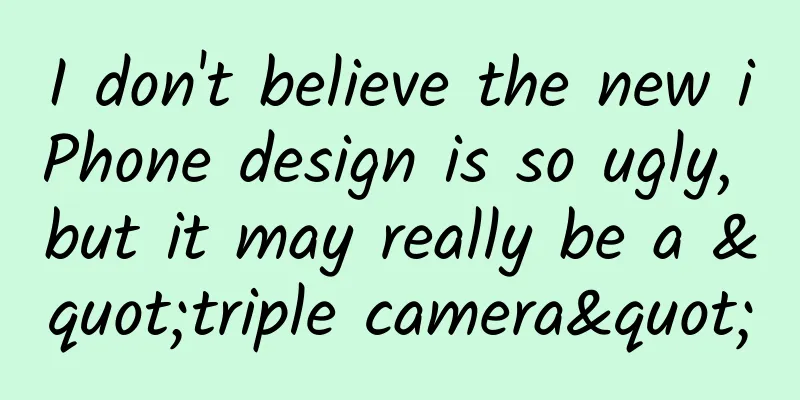I don't believe the new iPhone design is so ugly, but it may really be a "triple camera"

|
After Apple suddenly announced a reduction in its quarterly revenue expectations last week, its stock price plummeted by nearly 10%, evaporating $70 billion overnight. In more than three months, its market value has fallen by more than $440 billion, equivalent to one Facebook or three McDonald's. In this context, the performance of this year's new iPhone is crucial. Whether it can attract more users, especially Chinese users, to buy the new iPhone may determine Apple's performance in 2019. Recently, the well-known whistleblower Onleaks cooperated with the Digit.in website to produce renderings of what is suspected to be the prototype of the new iPhone in 2019. It is said that the new iPhone will be named iPhone XI, and it will use three rear cameras forming a square matrix with the flash. The ugliest iPhone rendering may not be the final one According to the renderings of Onleaks, the three rear cameras of the new iPhone are not arranged vertically or horizontally. Instead, the third camera is placed in the middle of the opposite side of the two vertical cameras, forming a square matrix with the flash in the upper right corner and the noise reduction microphone in the lower right corner. This design is hard not to remind people of the camera arrangement of Huawei's Mate 20 series. Although the camera level of this phone is still better than its peers, it has also been criticized by many netizens because the rear camera design looks like a "bathroom heater". However, Onleaks also stated that the renderings of the new iPhone are based on the engineering verification test (EVT) hardware design. The final design has not yet been confirmed, and the details may be adjusted when it is launched in September this year. However, the Digit.in website that cooperated with Onleaks stated that this is the closest rendering to the new iPhone in 2019. The engineering verification test (EVT) hardware mentioned by Onleaks is actually one of the stages of hardware development. The whole process can be roughly divided into EVT (engineering verification and testing stage), DVT (design verification and testing stage), PVT (production verification and testing stage) and MP (mass production stage). The EVT is in a relatively early stage, and is only for the purpose of having an engineering sample for initial testing to consider the feasibility of the design. There may also be multiple samples with different design schemes, which are often quite different from the finished products. The "ugliest" iPhone may not necessarily be what Apple's new flagship will look like this year. In fact, rumors about the new iPhone using three cameras began to circulate last year. Bloomberg once revealed that the new iPhone in 2019 may adopt a rear three-camera and be equipped with 3D ToF technology similar to that on OPPO R17 Pro. Compared with 3D structured light technology, 3D ToF technology can identify farther distances. In theory, it can achieve a working distance of 0.4-5 meters or even 7 meters. Therefore, it is more suitable for use on rear cameras, while the front camera continues to be handled by structured light with better accuracy. Not long ago, Sony also stated that the next-generation 3D sensor chip will be mass-produced this year and will be used in the front and rear 3D cameras of many smartphone manufacturers, most likely including Apple.
Deutsche Securities technology analyst Lu Jialin also said that the new generation of iPhone will use three rear cameras, but will not adopt the ToF solution. Two of the lenses will use stereo vision technology, and the other will be a telephoto lens, allowing users to zoom and shoot. However, a research report by Anne Lee, an analyst at Japan's Nomura Securities, shows that the three new iPhones in 2019 will continue to use the appearance design (size and display) of this year's three flagship models, XS, XS Max and XR. Apart from adding some new AR-related features, there will be no major updates.
Anne Lee also pointed out in the report that 2019 will be the first year that the iPhone uses the iPhone X design architecture. Apple will prepare for the initial hardware specifications of new technologies such as 5G and AR, and make greater architectural upgrades to 5G and a more comprehensive AR system, but this new iPhone will have to wait until 2020. I imagine that various revelations will continue to come in the next few months, but the final answer will not be revealed until September. No matter how powerful the algorithm is, the iPhone needs more cameras Last week, Cook mentioned in Apple’s investor letter that the decline in Greater China far exceeded expectations and was an important reason why iPhone revenue was lower than expected.
In addition to the price, another important reason why consumers are not buying the iPhone is that the iPhone's hardware level no longer has a clear advantage over domestic mobile phone manufacturers, including the camera function that many users are concerned about. At present, mobile phones have become the most commonly used photography tool for the vast majority of people. Statistics from the photo-sharing website Flickr show that half of the photos uploaded to the platform in 2017 came from smartphones, while the proportion of SLR cameras was only 33%. Photography has also become one of the main selling points of more and more mobile phone manufacturers. In 2018, when many domestic mobile phones have already used triple cameras, Apple's high-end flagship iPhone XS series still uses dual cameras, which seems to be a step behind. However, thanks to algorithm optimization, the iPhone XS series is still one of the best camera smartphones on the market. Although the hardware upgrade of the iPhone in 2018 is not significant, following last year's portrait lighting mode, the iPhone XS has newly added AI support in the ISP unit, realizing the full-process intelligent HDR function. Each finished film uses multi-frame synthesis technology, with richer highlights and shadows, and good image quality at night.
In the test of DXOMark, a professional camera evaluation organization, the iPhone XS Max scored 105 points, second only to the Huawei P20 Pro with a score of 109. DXOMark also stated that the improvements in software and image processing of the iPhone XS Max are very significant. However, no matter how powerful the software algorithm is, it still needs matching hardware to work best. Some photo-taking functions cannot be achieved by software alone. The saying "a bigger sensor can kill people" is not completely without reason. In DXOMark's test, the reason why the iPhone XS Max's photography is slightly inferior to that of the Huawei P20 Pro is that in weaker light, its luminance noise is more obvious than other high-end mobile phones (such as the Huawei P20 Pro or Galaxy Note 9), and rough luminance noise also appears on zoom images.
iFanr recently conducted a photo-taking comparison among the three flagships: iPhone XS Max, Galaxy Note9 and Mate 20 Pro. Although the three phones have their own advantages in taking photos, the gap in hardware is a small regret for the iPhone XS Max, as iFanr said in the review summary:
Moreover, for special scenes like ultra-wide angles, many flagships can only use panoramic mode or "external lenses" to achieve this. However, the Mate 20 Pro is equipped with a 16mm ultra-wide-angle lens that can directly shoot native ultra-wide angles. The effect is of course more natural than that optimized through algorithms.
Although Huawei still has a certain gap compared with Apple and Google phones in terms of software algorithms, the photography capabilities of Huawei phones such as P20 and Mate 20 are in the leading position among mobile phone manufacturers thanks to the accumulation of hardware such as ultra-large CMOS image sensors. This has also weakened the appeal of the iPhone to Chinese consumers to a certain extent. The iPhone is still powerful, but after experiencing the shock brought by the iPhone 4s, we have always expected the iPhone to be the best smartphone on the market, leading in terms of screen, craftsmanship, performance and photography. Now it seems that this is not the case.
With the rise of domestic manufacturers and the gradual saturation of the smartphone market, Apple has also encountered a bottleneck. This is also the dilemma of the entire industry, which cannot be summed up in one sentence: "lack of innovation." However, in order to reverse the downward trend of the iPhone in the Chinese market while maintaining high pricing, key configurations such as camera must at least not lose to competitors. In 2019, when triple-camera phones are becoming more popular and quad-camera phones are beginning to appear, Apple may find it difficult to get more consumers to accept dual-camera phones priced over 10,000 yuan. |
<<: Using design to increase conversion rate by 31%! How did Alibaba’s experts do it?
>>: 2018 Technology Company Atlas: The Birth and Fall of the Top Ten "Internet Celebrity" Apps
Recommend
Insights into advertising media advertising trends in Q3 2021
As the current leaders in short video, Tik Tok an...
Traveling during the Spring Festival, be stylish but don’t ignore the food
Nowadays, the way people celebrate the Spring Fes...
How to do investment advertising?
Nowadays, investment promotion advertisements are...
How can refined operations impress users?
The world has suffered from low conversion rates ...
How to improve brand loyalty through integrated marketing?
I will lead you to understand what marketing acti...
Can fingers also be infected with HPV? Many girls love to do this, but be careful →
Ms. Wu, 22, is a nail art enthusiast who goes to ...
Without these four skills, you are embarrassed to say that you are a product developer
The importance of design in the tech industry is ...
What if Hammer had priced the phone at 1999?
The biggest news in the mobile phone industry rec...
How can the elderly exercise healthier? The key is to do these five things
This is the 5019th article of Da Yi Xiao Hu Real ...
Dragon Head Secret Agent White Horse Secret Agent Zhong Zhan 27th Quantitative Science Dragon Catching Special Forces
Dragon Head Spy White Horse Spy Zhong Zhan 27th Q...
3 tips to make event operations more efficient!
Today, let’s talk about event operations . The so...
What kind of magical existence is the “irritating food” that we have heard about since childhood?
"Mutton is fat, don't eat it" "...
How to plan an event? Master these 10!
New employees in the workplace often encounter a ...
An information flow advertising landing page worthy of collection by all industry professionals
We all know that the task of most landing pages i...
【Little Mushroom】Human Skeleton and Muscle Understanding: Basic Course of Anime Character Drawing
【Little Mushroom】Human Skeleton and Muscle Unders...









